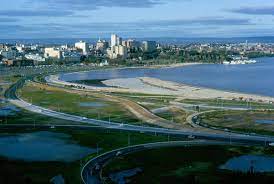Land Reclamation:

The increasing economic importance of coastal zones, particularly in East Asia, the Middle East, and West Africa, has led to significant land reclamation projects worldwide.
- These projects face environmental challenges and potential risks from rising sea levels and storm surges.
- Land Reclamation refers to the process of creating new land by altering the topography of existing bodies of water, such as seas, rivers, lakes, or marshes.
- It is typically done along coastlines but can also occur inland, involving the conversion of wetlands or other water bodies.
- Land reclamation has a long history of being used to expand coastal areas for agriculture and industrial purposes.
- Traditionally, land reclamation meant building a series of dikes to enclose tidal marshes or shallow offshore waters and draining these enclosures to create dry land.
- In some cases, streams were diverted to carry additional sediment into these areas, building up the land to a higher level.
- Soil and stone could also be excavated from the mainland and dumped along the shore or on the coast of existing islands, gradually expanding the land into the sea.
- Today, major engineering projects involve the construction of kilometres of offshore concrete barrier walls, which are filled with substantial amounts of sand, earth, clay or rock, often shipped in from far afield.
- The reclamation site can also be filled with dredged soil from the nearby seafloor mixed with water, in a process known as hydraulic reclamation.
- The study, which examined satellite imagery of coastal cities with a population of at least 1 million, found that reclamation projects in 106 cities around the world had altogether created around 2,530 square kilometres (more than 900 square miles) of coastal land.
- Nearly 90% of new coastal land was created in East Asia over the last two decades, most often to make way for industry and port facilities catering to the globalised economy.
- From 2000 to 2020, China alone added around 350 square kilometres, with Singapore and Incheon, in South Korea, also raising vast new areas.




